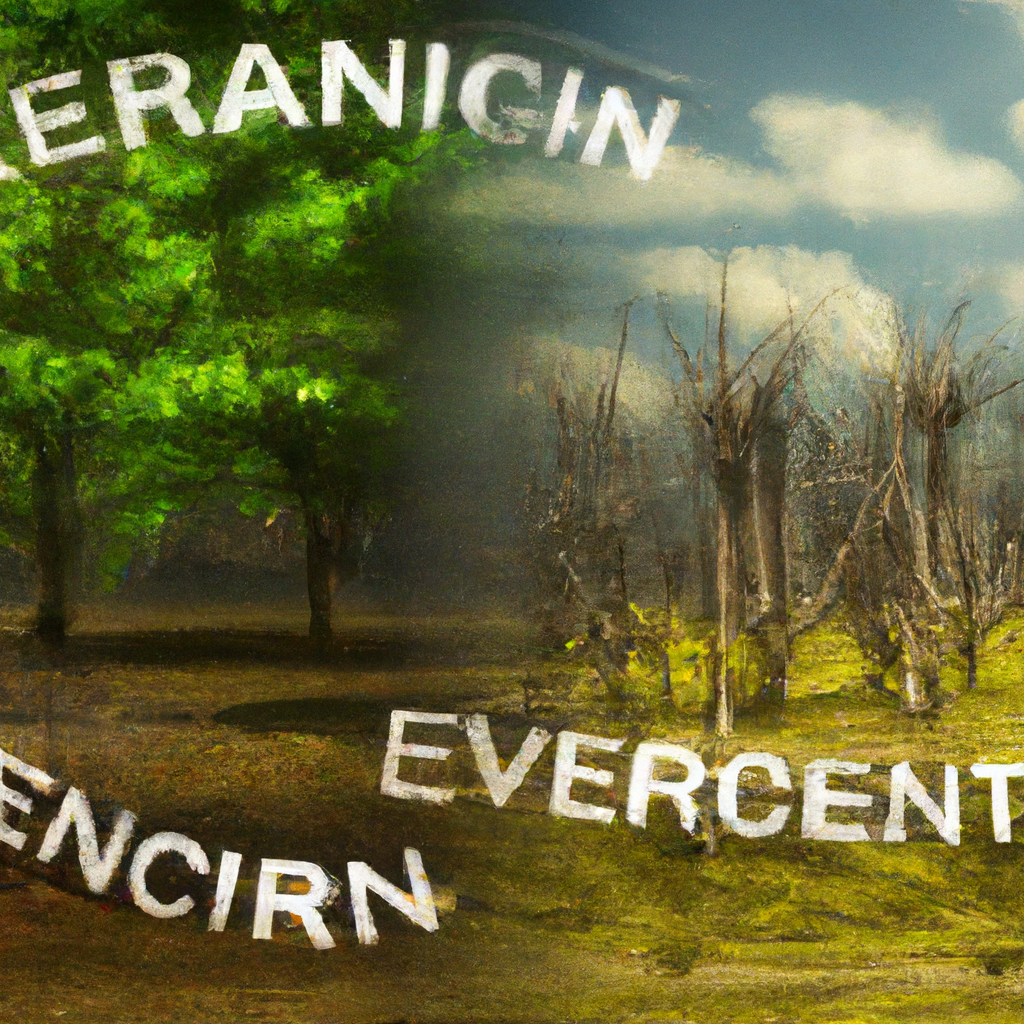Imagine a world where the vibrant colors of birds no longer grace the skies, where lush forests turn barren, and where the delicate balance of nature is disrupted. This is the alarming reality we face today as the loss of biodiversity continues to impact ecosystems and humans. As species disappear at an alarming rate, the consequences ripple through the interconnected web of life, affecting not only the natural world but also the well-being of our own species. In this article, we will explore the devastating effects of biodiversity loss on both ecosystems and humans, shedding light on the urgent need for conservation efforts to ensure a sustainable future for all.

Check Out Our Top Eco Friendly Product Picks On Amazon Here
Loss of Biodiversity and Ecosystem Functioning
Biodiversity plays a crucial role in the functioning of ecosystems. Ecosystems are complex networks of interactions between different species, and the diversity of species within an ecosystem is what creates a balance and stability. Each species has a unique role and contributes to various ecological processes such as nutrient cycling, pollination, and predation. When there is a loss of biodiversity, these crucial interactions are disrupted, leading to a decline in ecosystem functioning.
Role of Biodiversity in Ecosystems
Biodiversity is the foundation of healthy ecosystems. Each species, no matter how small or seemingly insignificant, has a role to play. Plants, for example, are the primary producers that capture energy from the sun through photosynthesis. They not only provide food and shelter for other organisms but also contribute to the overall stability and resilience of the ecosystem. Insects, on the other hand, act as pollinators, facilitating the reproduction and dispersal of plants. Predators help regulate population sizes, preventing the overgrowth of certain species. Hence, every species in an ecosystem contributes to its overall functioning and stability.
Interconnectedness of Species
One of the most remarkable aspects of biodiversity is its interconnectedness. Species within an ecosystem are interdependent, relying on each other for survival and reproduction. A loss of biodiversity can disrupt these intricate connections, creating a ripple effect throughout the ecosystem. For instance, if a plant species is lost, it can potentially impact the entire ecosystem by reducing food sources and disrupting the habitat for other organisms. Such cascading effects have been observed in various ecosystems worldwide, emphasizing the importance of maintaining a diverse range of species.
Key Indicators of Biodiversity Loss
It is essential to monitor and understand the loss of biodiversity to mitigate its impacts effectively. Several indicators can help us assess the extent of biodiversity loss in an ecosystem. Species richness, which refers to the number of different species present, is a commonly used indicator. A decline in species richness indicates a loss of biodiversity. Another indicator is species evenness, which measures the relative abundance of different species within a community. A decrease in species evenness suggests a disturbance in the ecosystem’s balance. Additionally, functional diversity, which considers the range of ecological roles performed by species, is another valuable indicator of biodiversity loss.
Impacts on Ecosystem Functioning
The loss of biodiversity can have severe consequences for ecosystem functioning. As species disappear, the intricate web of interactions that sustains the ecosystem begins to unravel. This can lead to a decline in various ecosystem processes and services. Nutrient cycling may be disrupted, affecting the availability and distribution of essential elements for plant growth. Pollination services may be impaired, reducing the reproductive success of plants and leading to decreased fruit production. The absence of key predators can result in population outbreaks of certain species, leading to imbalances within the ecosystem. In essence, the loss of biodiversity disrupts the functioning of ecosystems and can have far-reaching effects on both ecosystem health and human well-being.
Effects of Biodiversity Loss on Ecosystem Services
Ecosystem services are the benefits that humans derive from the functioning of ecosystems. These services can be categorized into four main types: provisioning services, regulating services, supporting services, and cultural services. The loss of biodiversity can significantly impact each of these service categories, with implications for human societies.
Provisioning Services
Provisioning services include the direct benefits humans obtain from ecosystems, such as food, water, and raw materials. Biodiversity loss can lead to a decline in the availability and quality of these resources. For example, the loss of pollinators may result in reduced crop yields, affecting food production. Additionally, the loss of plant diversity can limit the availability of medicinal resources, impacting traditional healthcare systems.
Regulating Services
Regulating services refer to the role of ecosystems in regulating natural processes such as climate, water purification, and flood control. Biodiversity loss can compromise these services by disrupting the underlying ecological processes. Forests, for instance, play a vital role in climate regulation by sequestering carbon dioxide from the atmosphere. The loss of forest biodiversity can diminish this capacity, contributing to climate change. Similarly, wetlands act as natural filters, purifying water and reducing the risk of flooding. The loss of wetland biodiversity can impair these regulating services, leading to water quality degradation and increased vulnerability to floods.
Supporting Services
Supporting services are the foundation of all other ecosystem services, providing the necessary conditions for life to thrive. These services include soil formation, nutrient cycling, and primary production. Biodiversity loss can undermine supporting services by disrupting these fundamental processes. For instance, the loss of soil organisms can result in decreased soil fertility and nutrient availability, affecting agricultural productivity. Similarly, the loss of primary producers such as algae and phytoplankton in aquatic ecosystems can disrupt the entire food chain, leading to a decline in fish populations and fisheries.
The Far-Reaching Impacts of Biodiversity Loss on Ecosystems and Human Well-being.
Cultural Services
Cultural services encompass the non-material benefits that ecosystems provide, such as recreational and aesthetic value, spiritual and cultural connections, and inspiration for art and literature. Biodiversity loss can diminish these cultural services, impacting human well-being and cultural identity. The disappearance of iconic species or the degradation of natural landscapes can erode the sense of place and cultural heritage associated with these ecosystems. Furthermore, the loss of biodiversity can deprive communities of opportunities for recreation, relaxation, and reflection in nature.
Check Out Our Top Eco Friendly Product Picks On Amazon Here
Impact of Biodiversity Loss on Food Security
Food security is a pressing global challenge, and biodiversity loss poses a significant threat to achieving and maintaining it. The loss of biodiversity can have several negative impacts on food security, affecting both the quantity and quality of food production.
Loss of Genetic Diversity
Biodiversity loss results in the loss of genetic diversity within crop and livestock populations. This reduction in genetic diversity limits the adaptive capacity of agricultural systems, making them more vulnerable to pests, diseases, and environmental changes. For example, a decrease in the genetic diversity of a particular crop variety can render it susceptible to a specific pest or pathogen, leading to crop losses. This can have ripple effects on food availability and affordability, ultimately impacting food security.
Disruption of Pollination
Many crops depend on the pollination services provided by insects, birds, and other animals. However, the loss of pollinators, including bees, butterflies, and bats, due to biodiversity loss, can result in decreased pollination rates and reduced crop yields. Without adequate pollination, fruit and seed production can be severely affected, leading to a decline in food production. In regions heavily reliant on agriculture, this can have significant implications for food security and livelihoods.
Reduced Resilience to Environmental Changes
Biodiversity loss can reduce the resilience of agricultural systems to environmental changes, such as climate variability and extreme weather events. Diverse crop varieties are more likely to have a range of genetic traits that enable them to tolerate different climatic conditions. However, the loss of biodiversity limits the availability of these resilient varieties, leaving agricultural systems more susceptible to the impacts of climate change, such as heatwaves, droughts, or floods. Reduced resilience to environmental changes can undermine food security by reducing crop productivity and increasing the vulnerability of communities dependent on agriculture.
Implications for Global Food Systems
The loss of biodiversity not only affects local food systems but also has implications for global food security. The interconnectedness of the global food system means that disruptions in one region can have far-reaching consequences. A decline in biodiversity can lead to decreased crop production and increased food prices, affecting food availability and access globally. In regions heavily reliant on agricultural exports, such as certain developing countries, the loss of biodiversity can have severe economic implications, further exacerbating issues of poverty and inequality.
Economic Consequences of Biodiversity Loss
The loss of biodiversity poses significant economic consequences for industries, livelihoods, and overall economic well-being. The intricate relationship between biodiversity, ecosystem services, and economic sectors highlights the importance of recognizing and valuing biodiversity in economic decision-making processes.
Impacts on Industries and Livelihoods
Many industries are directly dependent on biodiversity and ecosystem services. For example, tourism relies on intact and diverse ecosystems, such as coral reefs, forests, and national parks, to attract visitors and generate revenue. The loss of biodiversity can result in the degradation of these natural attractions, reducing tourist numbers and impacting local economies. Similarly, fisheries and forestry sectors are reliant on the sustainable management of biodiversity-rich ecosystems. Overexploitation and habitat degradation can lead to the collapse of fish stocks, loss of timber resources, and negative impacts on the livelihoods of communities dependent on these industries.
Costs of Species Extinction
The extinction of species carries significant economic costs. Each species has a unique set of traits and adaptations that contribute to ecosystem functioning and provide valuable services. When a species goes extinct, these services are lost, resulting in economic implications. For example, the extinction of a particular insect species that acts as a natural pest control agent can lead to increased reliance on chemical pesticides, which are costly and can have adverse environmental effects. Additionally, the loss of species with potential medicinal properties may limit the development of new drugs and therapeutics, impacting the pharmaceutical industry and healthcare sector.
Valuing Biodiversity
Assigning a monetary value to biodiversity can help policymakers and stakeholders recognize its importance and incorporate it into economic decision-making. Economic valuation methods, such as contingent valuation and cost-benefit analysis, can provide insights into the economic benefits derived from biodiversity and the potential costs of its loss. By valuing ecosystem services, such as pollination, carbon sequestration, and water purification, it becomes possible to assess the economic impacts of biodiversity loss and make informed decisions that consider both the short-term economic gains and the long-term sustainability of ecosystems.

Health Implications of Biodiversity Loss
Biodiversity loss has far-reaching health implications for both human and ecological well-being. The intricate relationships between biodiversity, ecosystems, and human health highlight the importance of conserving and restoring biodiversity for the benefit of public health.
Impact on Disease Dynamics
Biodiversity loss can influence the dynamics of infectious diseases, including zoonotic diseases that are transmitted between animals and humans. When ecosystems are disrupted and species interactions are altered, it can create opportunities for the emergence and spread of diseases. For example, deforestation and habitat fragmentation can bring humans into closer contact with wildlife, increasing the risk of disease transmission. Additionally, the loss of natural predators and competitors can lead to an increase in disease-carrying species, such as rodents, further escalating the risk of outbreaks. By preserving biodiversity and maintaining intact ecosystems, we can reduce the likelihood of disease transmission and protect human health.
Unraveling the Web of Life: The Far-Reaching Impacts of Biodiversity Loss on Ecosystems and Human Well-being.
Loss of Medicinal Resources
Many traditional and modern medicines are derived from natural sources, such as plants, animals, and microorganisms. Biodiversity loss threatens the availability of these medicinal resources, impacting the development of new drugs and alternative treatments. Traditional medical systems, particularly those used by indigenous communities, heavily rely on the knowledge of local biodiversity and its healing properties. The loss of biodiversity can erode this traditional knowledge and limit the options for healthcare and medical treatments. Thus, preserving biodiversity is essential to ensure a wide range of medicinal resources for future healthcare needs.
Psychological and Social Well-being
Biodiversity loss can also impact psychological and social well-being. Natural environments, rich in biodiversity, have been shown to enhance mental health, reduce stress, and promote relaxation and well-being. The beauty and diversity of nature provide a source of inspiration and connection that contributes to human happiness and quality of life. However, the loss of biodiversity and degradation of natural spaces can lead to a disconnection from nature, adversely affecting mental health and overall well-being. Access to biodiverse environments and the preservation of natural landscapes are vital for promoting positive psychological and social outcomes.
Biodiversity Loss and Climate Change
Biodiversity loss and climate change are interconnected challenges that exacerbate each other’s impacts. The loss of biodiversity contributes to climate change, while climate change, in turn, affects biodiversity. Understanding these complex interactions is crucial for effective conservation and mitigation strategies.
Feedback Loops and Synergistic Effects
Biodiversity loss and climate change can create feedback loops and synergistic effects that amplify their impacts. For example, as biodiversity declines, ecosystems become less resilient to climate change. This reduced resilience can result in the loss of more species, further reducing ecosystem stability and the ability to cope with climate extremes. Additionally, climate change can accelerate biodiversity loss by altering temperature and precipitation patterns, disrupting species’ habitats, and exacerbating the spread of invasive species. These feedback loops and synergistic effects create a dangerous cycle that threatens both biodiversity and climate stability.
Contribution to Climate Change
Biodiversity loss contributes to climate change through various mechanisms. One of the primary drivers is deforestation, which not only eliminates valuable habitats but also releases large amounts of stored carbon dioxide into the atmosphere. Forests act as carbon sinks, absorbing and storing carbon dioxide, a greenhouse gas responsible for climate change. When forests are cleared or degraded, this stored carbon is released, contributing to increased greenhouse gas concentrations. The loss of biodiversity in other habitats, such as grasslands and wetlands, also reduces their ability to sequester carbon dioxide, further exacerbating climate change.
Impacts on Climate Regulation
Biodiversity loss can disrupt the ability of ecosystems to regulate climate at both local and global scales. Forests, for example, play a vital role in climate regulation through the process of photosynthesis, which absorbs carbon dioxide and produces oxygen. The loss of forest biodiversity reduces this carbon sequestration capacity, resulting in increased atmospheric carbon dioxide levels. Additionally, wetlands help regulate climate by storing and releasing water, thereby moderating hydrological cycles. The degradation of wetland biodiversity can impair this regulatory function, leading to increased flooding or water scarcity, depending on the context. Preserving and restoring biodiversity-rich ecosystems is crucial for climate regulation and combating climate change.
Mitigating Climate Change through Biodiversity Conservation
Conserving biodiversity is not only essential for its intrinsic value but also for mitigating climate change. Biodiversity-rich ecosystems, particularly forests, serve as natural climate solutions by sequestering carbon dioxide from the atmosphere. Protecting and restoring these ecosystems can contribute to global efforts to reduce greenhouse gas emissions and combat climate change. Furthermore, intact and diverse ecosystems are more resilient to climate impacts, such as increased temperatures and extreme weather events. They provide natural buffers and adaptability, helping communities and ecosystems cope with the effects of climate change. Therefore, integrating biodiversity conservation into climate change mitigation strategies is crucial for achieving sustainable and resilient futures.

Biodiversity Loss and Water Resources
Biodiversity loss profoundly affects water resources, including water quality and availability. The intricate relationship between biodiversity and water highlights the need to protect and restore biodiversity-rich ecosystems to ensure the sustainability and health of water systems.
Role of Biodiversity in Water Cycle
Biodiversity plays a critical role in the water cycle, influencing various processes such as evaporation, precipitation, and water retention. Vegetation, from forests to wetlands, plays an essential role in regulating the water cycle. Through transpiration, plants release water vapor into the atmosphere, contributing to cloud formation and precipitation. Additionally, the complexity and diversity of vegetation within a watershed can influence water retention and infiltration, reducing the risk of floods and sustaining water availability during dry periods. Therefore, the loss of biodiversity can disrupt the water cycle, leading to water-related challenges such as reduced water quantity and quality.
Impacts on Water Quality
Biodiversity loss can have detrimental impacts on water quality. Healthy and biodiverse ecosystems act as natural filters, removing pollutants and improving water quality. Wetlands, for example, have a remarkable ability to filter and purify water, removing excess nutrients, sediments, and contaminants. The loss of wetland biodiversity can diminish this ecosystem service, resulting in increased water pollution and eutrophication. Similarly, the loss of forest ecosystems removes the natural protection forests provide by filtering water and reducing soil erosion. This can lead to increased sedimentation and nutrient runoff into water bodies, compromising their quality and posing risks to human and ecological health.
Interactions with Water Availability
Biodiversity loss can also impact water availability, both in terms of quantity and timing. Intact and biodiverse ecosystems contribute to water availability by regulating water flow and groundwater recharge. Forests, for example, act as natural sponges, absorbing and slowly releasing water, contributing to stable water supplies. When forests are degraded or cleared, this regulating effect is diminished, leading to more rapid runoff and decreased water availability during dry periods. Additionally, the loss of wetland ecosystems reduces their capacity to retain water, exacerbating the risk of flooding during heavy rainfall events. Preserving and restoring biodiversity-rich ecosystems is essential for maintaining water availability and ensuring sustainable water resources for people and nature.
Effects on Aquatic Ecosystems
Biodiversity loss has severe consequences for freshwater and marine ecosystems. These ecosystems are among the most biodiverse habitats on Earth, supporting a wide range of species and providing essential services to humans. The loss of biodiversity in freshwater ecosystems, such as rivers and lakes, can lead to imbalances within food webs, affecting fish populations and aquatic biodiversity. Similarly, the loss of coral reefs, known as the “rainforests of the sea,” can result in the decline of numerous species and the loss of valuable habitats. Biodiversity loss in these ecosystems can have cascading effects on both ecological and human well-being, underscoring the need for conservation and restoration efforts.
Loss of Biodiversity and Ecosystem Resilience
Biodiversity loss compromises the resilience of ecosystems, making them more susceptible to disturbances and less capable of recovering. Understanding the implications of biodiversity loss on ecosystem resilience is vital for effective restoration and conservation practices.
Reduction in Ecosystem Stability
Biodiversity loss reduces the stability of ecosystems, making them more vulnerable to disturbances and fluctuations. Biodiverse ecosystems tend to have more complex and interconnected networks of species interactions, which provide stability and resistance to change. When species are lost, these networks become simplified, and the capacity of ecosystems to withstand disturbances diminishes. Fewer species can lead to a higher susceptibility to invasive species, increased competition, and changes in resource availability, all of which can disrupt ecosystem stability. The loss of biodiversity erodes the resilience of ecosystems, making them more prone to tipping points and irreversible changes.
Increased Vulnerability to Disturbances
Biodiversity loss renders ecosystems more vulnerable to disturbances, such as extreme weather events, habitat destruction, and pollution. The presence of a diverse range of species within an ecosystem provides a buffer against disturbances, as each species contributes to different ecological functions and responses. However, when biodiversity is reduced, the ability of ecosystems to absorb and recover from disturbances is compromised. For example, a forest with a high diversity of tree species is more likely to recover from a wildfire than a forest dominated by a single species. Therefore, biodiverse ecosystems are more resilient to disturbances, highlighting the importance of conserving biodiversity to ensure ecosystem health and recovery.
Loss of Redundancy and Functional Redundancy
Biodiversity loss results in the loss of redundancy within ecosystems, diminishing their ability to cope with disturbances. Redundancy refers to the presence of multiple species that perform similar ecological functions. This redundancy provides a backup system, ensuring that if one species is lost, other species can step in and fulfill the ecological role. When biodiversity decreases, the loss of redundancy reduces the resilience of ecosystems. Additionally, the loss of functional redundancy, where different species perform complementary functions, can further compromise ecosystem resilience. For example, the loss of both primary producers, such as plants, and their associated pollinators can have far-reaching impacts on ecosystem functioning. Thus, maintaining both redundancy and functional redundancy is crucial for enhancing ecosystem resilience and restoring degraded systems.
Implications for Restoration and Conservation
The understanding of the relationship between biodiversity loss and ecosystem resilience is essential for the development of effective restoration and conservation strategies. Restoring and conserving biodiversity-rich habitats is crucial for rebuilding ecological networks and enhancing ecosystem resilience. This can involve reestablishing native species populations, restoring degraded habitats, and protecting intact ecosystems. Additionally, promoting connectivity between fragmented habitats allows for the movement of species and genetic exchange, enhancing the resilience of ecosystems to future disturbances. By recognizing and addressing the impacts of biodiversity loss on ecosystem resilience, we can work towards restoring and conserving healthy and functioning ecosystems for the benefit of both people and nature.

Effects on Indigenous Communities and Traditional Knowledge
Biodiversity loss has significant implications for indigenous communities and their traditional knowledge systems. Indigenous people often have a deep and intimate relationship with their local biodiversity, relying on it for sustenance, cultural practices, and spiritual beliefs. The loss of biodiversity threatens the livelihoods, cultural heritage, and well-being of these communities.
Dependency on Biodiversity
Many indigenous communities have a close dependency on biodiversity for their subsistence and survival. They rely on diverse ecosystems for hunting, fishing, gathering medicinal plants, and cultivating traditional crops. The loss of biodiversity can significantly impact the availability and accessibility of these resources, leading to food insecurity and loss of livelihoods. Additionally, indigenous communities often have traditional ecological knowledge that is intricately linked to their biodiversity-rich territories. This knowledge, passed down through generations, guides their sustainable resource management practices and contributes to the overall conservation of biodiversity.
Cultural and Spiritual Significance
Biodiversity holds immense cultural and spiritual significance for indigenous communities. Many indigenous cultures have strong connections to their local ecosystems, considering them sacred and integral to their identity. Traditional ceremonies, rituals, and spiritual beliefs are often deeply intertwined with the natural world and its diverse species. The loss of biodiversity can sever these cultural and spiritual connections, eroding the cultural heritage and identity of indigenous communities. It can also lead to the erosion of traditional knowledge systems, as the loss of species makes it more challenging to carry out traditional practices and ceremonies.
Threats to Traditional Practices
The loss of biodiversity poses a threat to the traditional practices and ways of life of indigenous communities. The destruction of habitats, pollution, and overexploitation of resources all contribute to the degradation of ecosystems and loss of species. These activities directly impact the ability of indigenous communities to continue their traditional practices, such as hunting, fishing, and gathering. Additionally, the loss of biodiversity can disrupt traditional farming systems, where indigenous communities have developed agroecological practices that are intricately connected to local biodiversity. The loss of these practices and the associated biodiversity can have profound social, economic, and cultural consequences for indigenous communities.
Safeguarding Indigenous Knowledge
Recognizing and valuing indigenous knowledge is vital for biodiversity conservation. Indigenous communities have developed sophisticated and sustainable management strategies that have ensured the longevity of their traditional territories and biodiversity. Sharing and integrating indigenous knowledge with scientific and conservation efforts can lead to more effective and culturally appropriate conservation practices. Respecting indigenous rights to land, resources, and self-determination is fundamental to preserving biodiversity and ensuring the well-being of indigenous communities. By safeguarding indigenous knowledge and empowering indigenous communities in conservation efforts, we can foster meaningful partnerships that promote biodiversity conservation and support the cultural resilience of indigenous peoples.
Conservation Strategies to Address Biodiversity Loss
Addressing the loss of biodiversity requires a comprehensive and multi-faceted approach that combines various conservation strategies. These strategies aim to protect and restore biodiversity-rich habitats, promote sustainable land use practices, manage invasive species, and raise awareness about the importance of biodiversity.
Protected Areas and Habitat Restoration
Protected areas play a crucial role in conserving biodiversity by providing safe havens for species and ecosystems. Establishing and effectively managing protected areas can help preserve critical habitats, prevent habitat loss, and promote the recovery of threatened species. Additionally, habitat restoration efforts can enhance biodiversity by reestablishing native plant and animal populations, improving degraded habitats, and creating connectivity between fragmented landscapes. Restoring degraded ecosystems not only improves biodiversity but also enhances ecosystem functioning and the provision of key ecosystem services.
Sustainable Land Use Practices
Promoting sustainable land use practices is essential for mitigating the impacts of biodiversity loss. This involves adopting practices that minimize habitat destruction, reduce deforestation, and prioritize ecosystem health. For instance, implementing sustainable agriculture practices, such as agroforestry or organic farming, can enhance biodiversity while ensuring food production. Avoiding or minimizing the use of harmful chemicals and promoting integrated pest management can help preserve beneficial insects and pollinators. Sustainable forestry practices, such as selective logging and forest restoration, can help maintain forest biodiversity while meeting timber demands. Encouraging sustainable land use practices at a global scale is crucial for conserving biodiversity and achieving sustainable development goals.
Invasive Species Management
Invasive species pose a significant threat to biodiversity, ecosystems, and human well-being. These non-native species can outcompete and displace native species, disrupt ecological processes, and alter entire ecosystems. Managing invasive species requires early detection, rapid response, and effective control measures. This can involve a combination of preventive measures, such as restricting the introduction and spread of invasive species, as well as targeted management strategies, such as biological control or removal. Invasive species management plays a vital role in restoring and conserving biodiversity-rich habitats, allowing native species to thrive and ecosystem functions to resume.
Education and Awareness
Raising awareness about the importance of biodiversity and its conservation is fundamental to mobilizing action and effecting change. Education and awareness campaigns can help people understand the value of biodiversity, the threats it faces, and the individual actions they can take to make a difference. This can involve promoting environmental education in schools, organizing community engagement programs, and disseminating information through various media platforms. By fostering a sense of connection and responsibility towards biodiversity, we can mobilize widespread action to protect and restore our natural heritage.
In conclusion, the loss of biodiversity has profound impacts on ecosystems and humans. Biodiversity loss disrupts ecological processes, reduces the availability and quality of ecosystem services, threatens food security, has economic consequences, affects human health and well-being, exacerbates climate change, impacts water resources, compromises ecosystem resilience, and has profound implications for indigenous communities and their traditional knowledge. Addressing biodiversity loss requires conservation strategies that protect and restore habitats, promote sustainable land use practices, manage invasive species, and raise awareness about the importance of biodiversity conservation. By valuing and conserving biodiversity, we can ensure the well-being of both ecosystems and human societies for generations to come.




